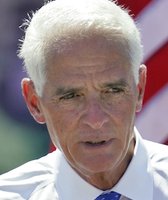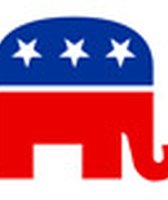Stand up for the facts!
Our only agenda is to publish the truth so you can be an informed participant in democracy.
We need your help.
I would like to contribute

Republicans have said a cap-and-trade plan will cost consumers every time they flip a switch.
With Congress considering a sweeping cap-and-trade bill to limit carbon emissions and slow global warming, there have been a perplexing array of cost estimates. We can't tell you which one is right — even the experts can't agree on that — but we wanted to provide an overview of the various studies to help you put them in perspective.
At its heart, cap-and-trade is a simple concept: To slow climate change, the government would set a cap on carbon dioxide and other greenhouse gas emissions. To comply, companies such as electric utilities must either upgrade to cleaner technologies or buy credits — also known as allowances — to continue polluting.
The cap-and-trade bill currently making its way through Congress was written by Reps. Henry Waxman and Edward Markey, Democrats from California and Massachusetts, respectively. Their goal is to lower carbon pollution by 17 percent by 2020 and 83 percent by 2050. Under their plan, most pollution permits initially would be given out for free. But eventually, companies would have to buy those permits from the government.
The Waxman-Markey cap-and-trade bill has drawn opposition from many Republicans who say that consumers will end up paying big bucks for the plan through higher energy bills. While both sides agree that consumers will end up paying more — Obama himself once said "
electricity rates would necessarily skyrocket
" — the actual amount is a matter of dispute.
Calculating the true cost of cap-and-trade will be difficult because the bill is in flux and its impact is complicated and hard to predict, said Barry Rabe, a public policy professor at the University of Michigan.
"Until all the moving parts are pinned down, making an accurate estimate is metaphysically impossible," he said.
But that won't stop the supporters and opponents from invoking the studies, so we thought it would be useful to give you an overview of the major studies:
* Of all the estimates we could find, the
one
from the Environmental Protection Agency had the lowest cost. (It's important to point out that the EPA is part of the Obama administration, which supports a cap-and-trade plan.) It says cap-and-trade will only cost consumers an average of $80-$111 a year — or about 22 to 30 cents a day — so long as most program revenue is returned to consumers. The EPA looked at higher energy prices, price changes for other goods and services, and impacts on wages through 2050. The EPA predicts that cost will fluctuate over the next 40 years as the cost of allowances generally goes up. For example, in 2020, the EPA estimates that allowances will cost about $16 per ton of carbon emissions and that means consumers will be paying upward of $61 a year. But in 2050, when allowances will no longer be free, consumers could pay anywhere from $123 to $174.
* The Congressional Budget Office, the independent number-crunching group in Congress, has the
newest study
that analyzes the specifics of the Waxman-Markey bill. It says the net annual economywide cost of the cap-and-trade program in 2020 would be $22 billion — or about $175 per household. It's important to read the fine print on this one, though. The CBO says the cost will vary depending on your wealth. Low-income consumers could expect to save $40 a year, while high-income consumers will see a net cost for energy of $235 to $340 annually. It's also important to note that the costs will vary year to year. CBO chose 2020 as a milestone for its analysis because it's a point at which the program would have been in effect for eight years, giving the economy and polluters time to adjust. But had the CBO chosen a later date, the cost per family may have been higher because the government would gradually be charging polluters more.
* The conservative Heritage Foundation
predicts
a much higher price tag: By 2035, cap-and-trade will increase the average family's annual energy bill by $1,241. The number is higher because the study assumes that traditional energy sources will be scaled back to meet new emissions standards, but will not be immediately replaced by new technology or renewable fuels. As a result, energy prices will go up and continue to rise, the Heritage report predicts. Both the CBO and EPA estimates assume that, at some point, cleaner technologies and renewable energy will replace fossil fuel, which will translate to lower costs to consumers. (The Heritage Foundation provides no information on its Web site as to when its model assumes this phase-in will occur, if at all.) To be fair, the EPA predits that renewable fuel production will actually be less than without a cap-and-trade plan in place; energy efficiency improvements will be the primary reason for lower emissions.
* The American Council for an Energy-Efficiency Economy, a group backed by businesses and utilities dedicated to advancing energy efficiency,
looked
at how much consumers would save from new energy-saving programs in the bill. For example, the combination of better building codes, more efficient appliances and building retrofits could save approximately $750 per household by 2020 and $3,900 per household by 2030.
* House Republicans have been citing a
2007 study
by the Joint Program on the Science and Policy of Global Climate Change at the Massachusetts Institute for Technology. They say it proves that consumers will pay up to $3,100 annually for cap-and-trade. PolitiFact
already rated
this claim Pants on Fire, not because of any flaws in MIT's work but because the author of the study says the GOP misinterpreted his findings. The author
wrote
Republican leaders to say that the study was being mistakenly cited. (He initially said the actual number was more like $340 a year, but has since corrected it to $800. See the update at the bottom of our Pants on Fire item for a full explanation.) It's important to note that the study was written in 2007, nearly two years before the Waxman-Markey bill was even introduced. As a result, the report is not an accurate source for information on the bill.
It's important to keep some perspective on all these numbers, because even the best models can't predict some of the long-term aspects of the Waxman-Markey bill, said Janet Peace, vice president of Markets and Business Strategy at the Pew Center on Global Climate Change,
"They're really good at drawing some general conclusions, and the results (of the CBO and EPA studies) imply that cap-and-trade will come at a relatively low cost to consumers," she said. "But these models are really bad at predicting how new technology will impact the bill. And they're not good at major shifts, such as a shift to renewables."
Nevertheless, Peace said consumers should pay close attention to the EPA and CBO studies, because, while they are not comprehensive, they come closer than the Heritage Foundation or MIT studies.
"Both models do the bill justice," she said. "They're trying to capture the major elements of the bill in an unbiased way."
Our Sources
Congressional Budget Office, Director's blog entry on cap-and-trade estimate , accessed June 25, 2009
The Wall Street Journal, EPA Sees Limited Renewable Energy Growth under Waxman-Markey , by Stephen Power, June 24, 2009
The Pew Center on Global Climate Change, Comparison of EPA and CBO studies , accessed June 25, 2009
The Wall Street Journal, MIT to Republicans: Lay Off the Scaremongering on Climate Costs , by Keith Johnson, April 2, 2009
The New York Time, How Much Will 'Cap and Trade Cost'? , by Casey B. Mulligan, May 27, 2009






















































